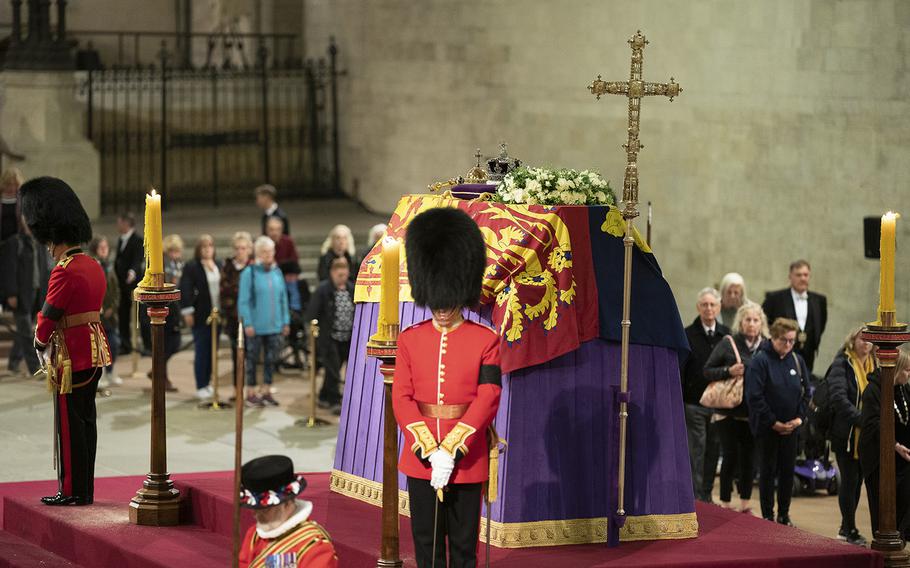
The coffin of Queen Elizabeth II lies in state inside Westminster Hall. (Sarah L. Voisin/Washington Post)
LONDON - The courtyards of the Palace of Westminster were echo quiet below a half-moon. You could hear a mouse rustle by the bins and smell the River Thames just steps away.
I don't work at Westminster, strictly speaking. But as a correspondent for The Washington Post, I am fortunate to have a lobby pass, which allows me to freely enter the estate to cover the debates - high and low - at the Houses of Commons and Lords.
Even lobby passes do not allow entrance into Westminster these days, however, not with the queen's coffin lying in state. One could join the miles-long queue and wait for hours, as soccer star David Beckham did along with hundreds of thousands of other people. "I thought by coming at 2 a.m. it was going to be a little bit quieter," he told ITV News. "I was wrong."
I applied for a press time slot. I got 2 a.m. on Saturday. A taxi dropped me off near MI5, the counterintelligence and domestic security service, a short walk to the media gate at Victoria Tower Gardens.
I've been on the grounds many times. This was different.
Westminster Hall is the oldest structure on the estate, the scene of royal banquets and the trials of King Charles I (beheaded), Guy Fawkes (hanged) and Sir Thomas More (beheaded). It was built in 1097 by the son of William the Conqueror, and those stones still stand. The hammer-beam roof, commissioned in 1393, has been called "the greatest creation of medieval timber architecture." It spans a width of 67 feet, without support pillars.
The trees of those beams were cut from royal woods, ferried to London by barge and cart. They're now adorned by angels with wings and shields. At the top of the stone walls are carved deer, with chains around their necks.
It is an amazement of engineering, history, design, art. And there, under that roof, I watched.
The people kept coming. Government and palace officials have been stunned by the numbers, a 24/7 procession expected to last until the queen's funeral on Monday morning at Westminster Abbey.
They entered, walked down the steps and paused before the closed coffin of the queen, which rests on a raised platform, known as a catafalque.
Atop the coffin, on a purple pillow, rests the crown.
Candles were burning, but the hall was not candlelit. It was bright as a train station. The most remarkable thing: the quiet and the solemnity.
The public is allowed no photography, and so there were no hands held aloft with smartphones. No selfies, no Instagram snaps, no Facebook Live.
People came wrapped in scarves, swaddled in puffer coats because of the nighttime chill. Some were dressed in funereal black and a few men in formal morning coats with vests. One woman wore what appeared to be an evening dress with pearls.
At the coffin, they paused. For a few seconds, but not longer. Some made the sign of the cross. I watched mourners move their lips, in prayer or thanks or memories. Others bowed, a dip of the head, or very deeply, from the waist.
Two people snapped to a smart military salute.
There were older men, with regimental berets and medals on their chests from past service. There were people with canes or in wheelchairs. One couple embraced, after passing the coffin, to comfort each other. Some mourners dabbed their eyes with tissues. One could be heard, faintly but audibly, weeping.
Every 20 minutes brought a changing of the guard. A staff struck the stone, and 10 bodyguards were refreshed by their counterparts, mirror images in their uniforms and bearing.
Surrounding the coffin, they stood like wax works: the Gentlemen at Arms with plumed headdresses and cavalry swords, the King's Guard in bearskin hats, the Yeomen of the Guard in scarlet tunics with staffs.
On Saturday evening, Princes William and Harry will come for a "grandchildren's vigil."